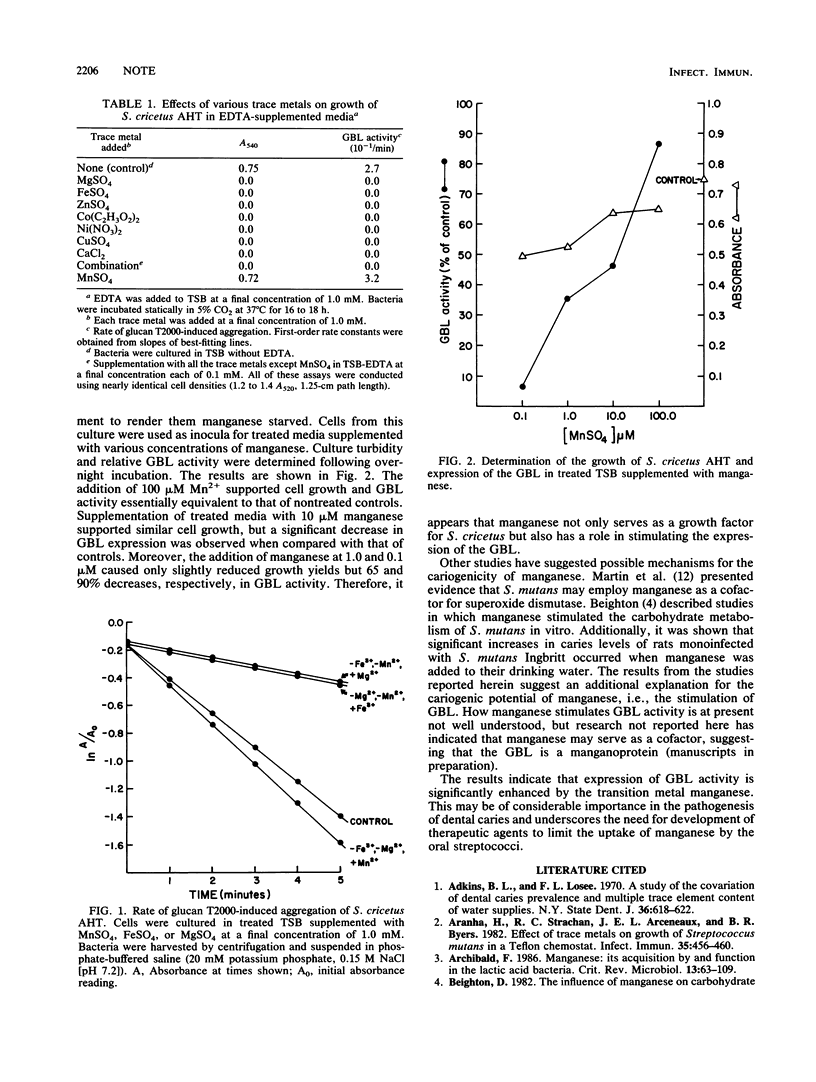Abstract
Streptococcus cricetus AHT exhibited a requirement for manganese for growth and expression of the glucan-binding lectin. While low concentrations of manganese (0.1 to 10 microM) were able to support growth, higher concentrations (greater than 100 microM) were required for full expression of the glucan-binding lectin. The manganous-aquo ion may be important in cellular adhesion and accumulation processes in dental plaque.
Full text
PDF


Selected References
These references are in PubMed. This may not be the complete list of references from this article.
- Adkins B. L., Losee F. L. A study of the covariation of dental caries prevalence and multiple trace element content of water supplies. N Y State Dent J. 1970 Dec;36(10):618–622. [PubMed] [Google Scholar]
- Aranha H., Strachan R. C., Arceneaux J. E., Byers B. R. Effect of trace metals on growth of Streptococcus mutans in a teflon chemostat. Infect Immun. 1982 Feb;35(2):456–460. doi: 10.1128/iai.35.2.456-460.1982. [DOI] [PMC free article] [PubMed] [Google Scholar]
- Archibald F. Manganese: its acquisition by and function in the lactic acid bacteria. Crit Rev Microbiol. 1986;13(1):63–109. doi: 10.3109/10408418609108735. [DOI] [PubMed] [Google Scholar]
- Beighton D. The influence of manganese on carbohydrate metabolism and caries induction by Streptococcus mutans strain Ingbritt. Caries Res. 1982;16(2):189–192. doi: 10.1159/000260596. [DOI] [PubMed] [Google Scholar]
- Bowen W. H. The trace element requirements of cariogenic and non-cariogenic streptococci. Arch Oral Biol. 1968 Jun;13(6):713–714. doi: 10.1016/0003-9969(68)90151-9. [DOI] [PubMed] [Google Scholar]
- Curzon M. E., Losee F. L. Dental caries and trace element composition of whole human enamel: Western United States. J Am Dent Assoc. 1978 May;96(5):819–822. doi: 10.14219/jada.archive.1978.0198. [DOI] [PubMed] [Google Scholar]
- Drake D., Taylor K. G., Bleiweis A. S., Doyle R. J. Specificity of the glucan-binding lectin of Streptococcus cricetus. Infect Immun. 1988 Aug;56(8):1864–1872. doi: 10.1128/iai.56.8.1864-1872.1988. [DOI] [PMC free article] [PubMed] [Google Scholar]
- Gibbons R. J., Fitzgerald R. J. Dextran-induced agglutination of Streptococcus mutans, and its potential role in the formation of microbial dental plaques. J Bacteriol. 1969 May;98(2):341–346. doi: 10.1128/jb.98.2.341-346.1969. [DOI] [PMC free article] [PubMed] [Google Scholar]
- Glass R. L., Rothman K. J., Espinal F., Vélez H., Smith N. J. The prevalence of human dental caries and water-borne trace metals. Arch Oral Biol. 1973 Sep;18(9):1099–1104. doi: 10.1016/0003-9969(73)90083-6. [DOI] [PubMed] [Google Scholar]
- Little M. F., Barrett K. Strontium and fluoride content of surface and inner enamel versus caries prevalence in the Atlantic coast of the United States of America. Caries Res. 1976;10(4):297–307. doi: 10.1159/000260210. [DOI] [PubMed] [Google Scholar]
- Martin M. E., Strachan R. C., Aranha H., Evans S. L., Salin M. L., Welch B., Arceneaux J. E., Byers B. R. Oxygen toxicity in Streptococcus mutans: manganese, iron, and superoxide dismutase. J Bacteriol. 1984 Aug;159(2):745–749. doi: 10.1128/jb.159.2.745-749.1984. [DOI] [PMC free article] [PubMed] [Google Scholar]
- STAMER J. R., ALBURY M. N., PEDERSON C. S. SUBSTITUTION OF MANGANESE FOR TOMATO JUICE IN THE CULTIVATION OF LACTIC ACID BACTERIA. Appl Microbiol. 1964 Mar;12:165–168. doi: 10.1128/am.12.2.165-168.1964. [DOI] [PMC free article] [PubMed] [Google Scholar]
- Schmid J., Auling G. Manganese transport in Brevibacterium ammoniagenes ATCC 6872. J Bacteriol. 1987 Jul;169(7):3385–3387. doi: 10.1128/jb.169.7.3385-3387.1987. [DOI] [PMC free article] [PubMed] [Google Scholar]


